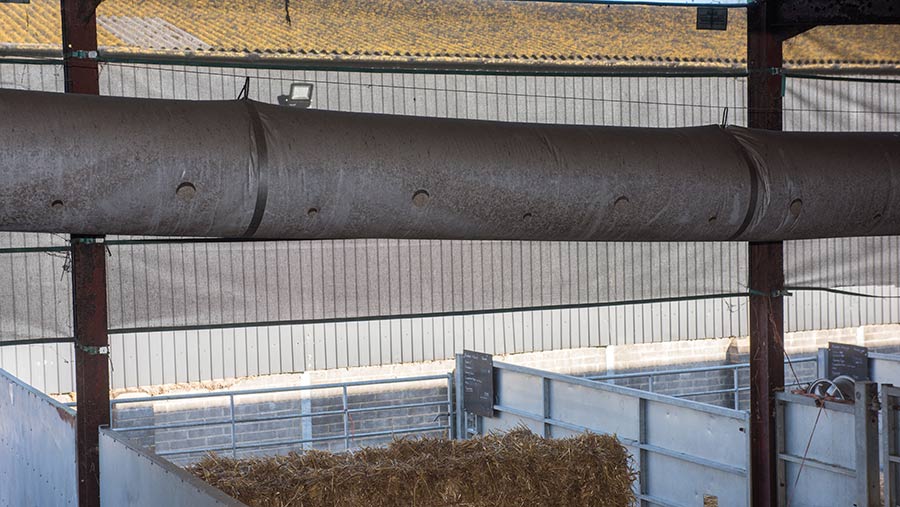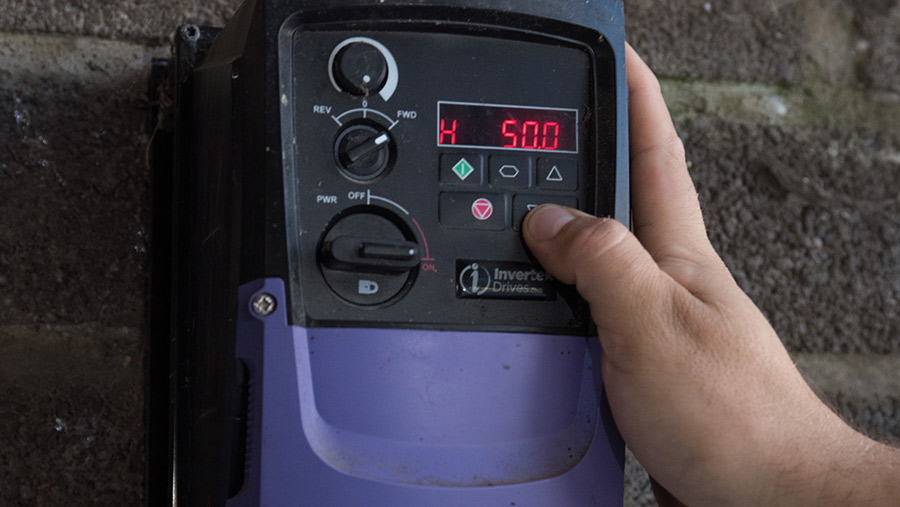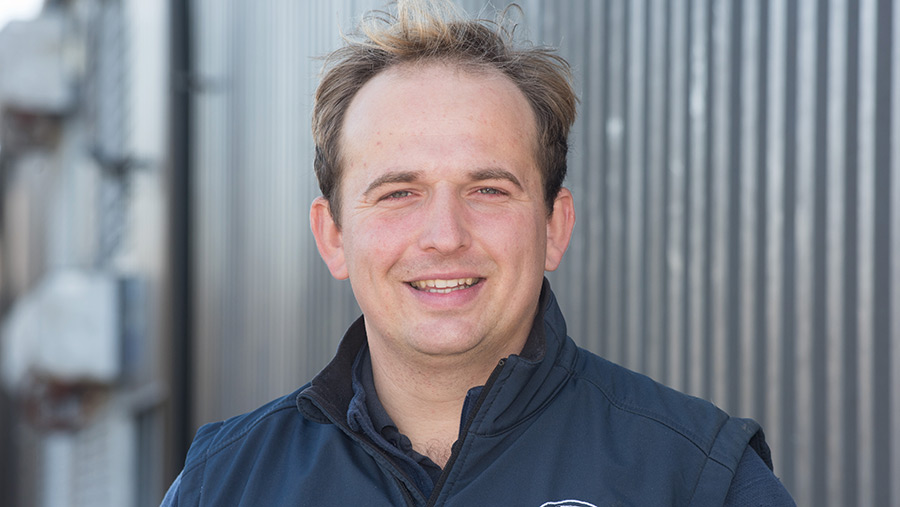Tips on using positive pressure tube ventilation in calf sheds
 Positive pressure tube ventilation can help reduce respiratory disease © Hugh Nutt
Positive pressure tube ventilation can help reduce respiratory disease © Hugh Nutt Most calf buildings could benefit from positive pressure tube ventilation (PPTV) systems which ensure fresh, clean and still air is delivered at calf height at every location in the shed.
PPTV is made up of a long tube that runs along the internal length of a calf building with an external fan at one end.
The fan sucks in clean air from outside which is blown down the tube and out of a series of holes along the tube’s length. This means air is distributed evenly throughout the shed.
The aim is to ensure every animal is exposed to the same environment and air is still when it reaches the calf.
A US farm study found that the absence of PPTV was associated with an 81% increase in calves being detected with a fever.
Consultant Jamie Robertson of Livestock Management Systems believes most calf sheds in the UK could benefit from their installation.
See also: How to improve old calf sheds on a budget
“Nearly all calf buildings, apart from those of very small dimension (such as hutches), need mechanical ventilation, which is most likely and optimally delivered by positive pressure tube ventilation,” he says.
His reasoning is based on several factors:
1. Baby calves can’t generate enough heat to drive the stack effect
The stack effect is when hot air rises, exits the building from an outlet and sucks in clean air from air inlets. This is reliant on sufficient body heat, but also enough inlet and outlet.
2. Insufficient inlet and outlet
One opening cannot be viewed as the inlet and outlet. Even if it is a large area, the stack effect will not be created and there will not be a directional airflow.
Opening up the back may help in a small building, but for larger buildings the only way to create that air flow is through mechanical ventilation.”
3. Still days
There will always be days when there’s no air movement.
PPTV helps with these factors, although it will not compensate for an insufficient outlet. “Getting the ‘in’ right doesn’t solve it.
If you don’t get the ‘out’ right with PPTV is can make it worse,” Mr Robertson stresses.
Cost/benefit
At about £1,200-£2,000, the cost of PPTV can often put farmers off. However, Mr Robertson believes the industry needs to get its head around valuing fresh air. PPTV can:
- Create a drier environment, reducing the risk of spreading aerosols, and potentially lowering bedding costs
- Help reduce respiratory disease – an AFBI study put the cost of respiratory disease at £700-£900 a head by the end of the second lactation if an animal had been treated twice or more during the milk feeding period.
Tips for making the most of PPTV
- Ensure the system is installed by a competent person
- PPTV will not solve issues with poor hygiene, nutrition or general management
- Maintenance is essential – dirty fans and/or dirty, ripped tubes will never work correctly. Fans and tubes should be cleaned two to three times a year
- Be prepared to change fans every five years and the tube every two years
Advice on design
There is no one-size-fits-all approach to PPTV. It’s essential any system is designed for an individual shed, and ideally by someone who has undertaken Wisconsin University’s PPTV design course, Mr Robertson says.
The size of the shed, the number of calves, and their location will influence design.
Considerations include:
1. Size of fan
- Fan capacity must provide a minimum ventilation rate of four air changes an hour
- Fan size will influence tube diameter – for example, if the tube is too narrow and the pressure too high, air will rush to the end and won’t be evenly distributed
2. Height and position of the tube
- The location and height of the tube will influence hole size and position
- If the tube is at the back of a shed, the holes will need to blow downwards and at 4 o’clock to push air into the building
- If the tube is in the middle, there could be a line of holes at 4 o’clock and 8 o’clock
3. Size of holes
- Hole sizes need to be customised so the calf resting area is blanketed with fresh air. If holes are too large, calves can be chilled; if the holes are too small, fresh air will not reach them
- Holes may vary in size to ensure air is delivered to all areas of the shed.

The system is operated from a simple control panel © Hugh Nutt
Case study – William Holmes, High House Farm, Dorset
Installing a positive pressure tube ventilation (PPTV) system in a shed used to rear calves up to a week old has helped reduce calf mortality by 63% and lowered antibiotics use by 86% at William Holmes’ High House Farm, Dorset.
In 2019, high airspeed and a lack of ventilation on still days – due to small calves not being able to drive the stack effect – were identified as contributory factors to calf pneumonia in the open-fronted, mono-pitch shed.

Will Holmes © Hugh Nutt
Heifer and beef calves from the 420-cow autumn block-calving herd are housed in this shed for the first week after birth and managed in groups of 12 across eight pens.
Synergy Farm Health vet Tom Shardlow advised putting in two staggered straw bales in each pen – one at the front and one in the middle.
Galebreakers were also installed at the top of the open front of the building. This provided calves with shelter and reduced drafts.
Having undertaken Wisconsin University’s PPTV design course, Mr Shardlow then designed a system for the shed. Features include:
- The tube is located at the front of the building, which is higher than the back, to allow machinery clearance
- The shed is about 1,600sq m, with the fan moving more than 7,000sq m of air an hour to deliver more than four air changes
- Holes are located on one side, facing into the shed, to deliver air to the back
Mr Holmes addressed colostrum management to ensure calves receive 10% of their body weight within six hours of birth.
He also tightened hygiene protocols and increased milk feeding rates.
“Between closing the shed in and putting the positive pressure tube in, we now don’t get pneumonia in that shed.
We haven’t jabbed a calf in that shed for two years,” he says.
As most antibiotics use was associated with this period, reducing pneumonia at this stage has lowered the overall rate of antibiotics, as well as youngstock mortality (see table below).
Calves are also stronger when they move out of this shed and into groups of 45.
Having paid £1,410 for the system, Mr Holmes believes it has paid for itself in two months. “Just in the first year, we had nine fewer calves die.
If we work on £250 a calf, that’s £2,250 just on deaths,” he says.
At the same time, 251 fewer doses of antibiotics equate to a saving of about £750-£1,000 in year one.
Improvements since PPTV was installed in 2019 |
|||
|
2018 |
2019 |
2020 |
|
|
Youngstock mortality (total calf deaths from birth to calving for any reason. It’s estimated that half is linked to pneumonia) |
27 |
18 |
10 |
|
Number of antibiotics doses administered to youngstock (for any reason, up to calving) |
307 |
56 |
43 |
| In 2018, about 130 heifer calves were reared. From 2019, both beef and heifer calves were reared, totalling about 570 head. | |||
